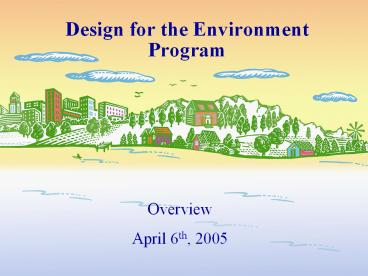Design for the Environment Program - PowerPoint PPT Presentation
Title:
Design for the Environment Program
Description:
Lead-Free Solder Partnership Life-Cycle Assessment. The U.S. electronics industry is ... Annual lead solder use in electronics. estimated at 176 million pounds ... – PowerPoint PPT presentation
Number of Views:20
Avg rating:3.0/5.0
Title: Design for the Environment Program
1
Design for the Environment Program
- Overview
- April 6th, 2005
2
Overview
- DfEs Unique License to Operate
- Past Success and Lasting Change
- Current Focus and Potential for Success
DfE Projects have touched more than 200,000
business facilities and approximately 2 million
workers.
3
DfEs Unique License to Operate
- DfEs value to industry and our unique license
to operate come from applying the technical
tools, models and expertise that OPPT has
developed through reviewing thousands of new
chemicals under TSCA.
4
Past Success andLasting Change
5
Example from the Drycleaning Industry
- The DfE Garment Care Partnership
- Encouraged the use of environmentally preferable
cleaning methods and - Promoted technology and best practices for
drycleaning with
perchloroethylene - Industry Perc. Use
- has Decreased
- Substantially
- DfE contributed to
the
reduction
6
Examples from the Electronics Industry
DfE aided U.S. manufacturers to promote
competitiveness and environmentally friendly
manufacture
- DfE Printed Wiring Board (PWB) Partnerships --
Examined cost, performance and environmental
profile - Surface Finishes comparison of lead
and non-lead methods - Reduction in lead use was estimated to be
2
million pounds per year over the first 3 years - Making Holes Conductive
- Benefits include
- 240,000 lbs. per year decrease in formaldehyde
use - 400 million gallons of water saved per year
- 15 billion BTUs of energy saved per year
7
Current Focus andPotential for Success
8
Lead-Free Solder Partnership Life-Cycle Assessment
- The U.S. electronics industry is moving away
from lead solder - E.U. will ban lead in electronics by 2006
- Industry approached DfE based on past
relationship - Partnership will help U.S. Industry
adopt lead-free
alternatives and
maintain international competitiveness - Tin-lead and three alternatives
- Significant potential for improvement
- Annual lead solder use in electronics
- estimated at 176 million pounds
- Draft results in Spring 2005
9
Furniture Flame Retardancy Partnership
- Collaboration between DfE, chemical and furniture
manufacturers, the Consumer Product Safety
Commission, and NGOs. - Inform and influence the selection of flame
retardants for foam - Predominant flame retardant being phased-out by
the end of 2004. - Need for fire safety will likely increase based
on planned national standards. - Decision-making for alternatives to a 15.7
million pound per year chemical. - Environmental and human health data paired
with
industry performance data. - Longer-term
- Develop health and safety data needed to
adequately risk characterization - Flame retardants in all furniture
components continued role for partnership - Targeted DfE Innovation Challenge
for chemical and non-chemical
solutions
10
DfE Formulator Partners with Chemical Product
Manufacturers to Improve Health and Environmental
Profile of Products
- DfE Review
- Considers Every Formulation Ingredient
- Prepares Health and Environmental Profile
- (Existing Data, Estimation Models, Chemical
Expertise) - Situates Chemical on Continuum
- of Improvement
- Recommends Safer Substitutes
Continuum of Improvement Formula Ingredient by
Use Class
Sustainable
Improved
Of Concern
Characteristics of Improved Ingredient
Characteristics of Sustainable Ingredient
Characteristics of Ingredient of Concern
11
DfE Formulator Partnerships
- Offer Companies Access to EPA Expertise, Advice
and Recognition - Yield Measures of Environmental Benefit
- Partnerships have reduced the use of
- millions of pounds of chemicals of
- concern
- More than 60 recognized products in
- the following sectors
- Industrial/Institutional Cleaners and
- Laundry Detergents, Holding Tank
- Treatments/Deodorizers, and
- Industrial Coatings
12
Asthma Reduction Strategy
- Background
- Diisocyanates - leading cause of occupational
asthma - Linked to asthma in children near foam facilities
- Ranked among the most toxic risk-screening (RSEI)
chemicals - Most Significant Uses
- Foam manufacture uses 69 of 2.2 billion pounds
of diisocyanates produced annually - Auto Refinish is most dispersive use
- DfEs Role
- Leverage the successful auto refinish
- partnership best practices approach
- Develop best practices for flexible foam
- Identifying hybrid isocyanate-free polyurethanes
13
Asthma Reduction Strategy (cont.)
- Project Planning for Flexible Foam
- Evaluate process efficiencies and best practices
- Identify incentives and cost/benefits
- Partner with foam facilities and conduct pilot to
measure results - Promote safer chemicals and processes
- Measure reduction in emissions and impact on
asthma reduction in community and workplace - Project Planning for Auto Refinish
- Work with stakeholders to develop a plan to
leverage best practices
14
Asthma Reduction Strategy (cont.)
- Potential Benefits
- Industry partnership and commitment to continuous
improvement - Cost savings, reduced emissions in plants and
neighborhood - Foam facilities gt331,000 lbs diisocyanates and
22 million lbs of other toxic air emissions
reported - Auto refinish gt 50,000 shops around the country
with potential worker and community exposure to
automotive paint overspray - Stakeholders
- Polyurethane foam manufacturers, chemical
manufacturers, paint formulators, trade
associations, raw material suppliers, ATSDR/CDC,
local government and communities
15
Summary
- Collaborate broadly
- Leverage OPPT technical tools and expertise
- Help businesses weigh
environmental
considerations and - Focus on opportunities
for lasting change.































